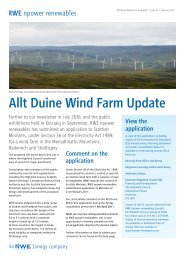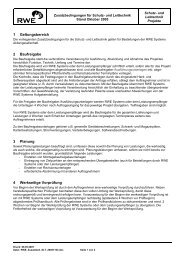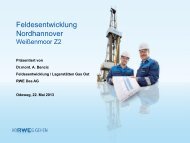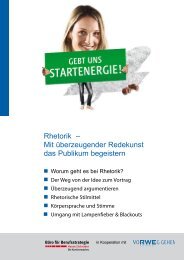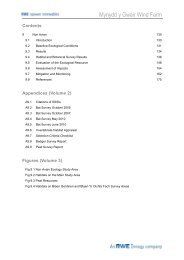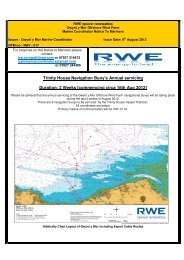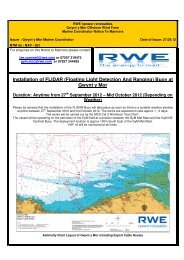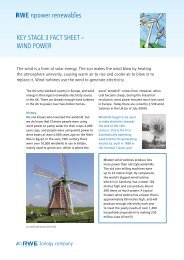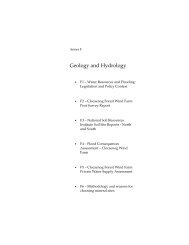Development status of WTA fluidized-bed drying for - RWE.com
Development status of WTA fluidized-bed drying for - RWE.com
Development status of WTA fluidized-bed drying for - RWE.com
You also want an ePaper? Increase the reach of your titles
YUMPU automatically turns print PDFs into web optimized ePapers that Google loves.
Article taken from:<br />
<strong>Development</strong> <strong>status</strong> <strong>of</strong><br />
<strong>WTA</strong> <strong>fluidized</strong>-<strong>bed</strong> <strong>drying</strong><br />
<strong>for</strong> lignite at <strong>RWE</strong> Power AG<br />
Kraftwerkstechnik – Sichere und nachhaltige Energie-<br />
versorgung – Volume 2, October 2010<br />
Dr. Hans-Joachim Klutz, <strong>RWE</strong> Power AG Köln<br />
Dipl. Ing. Claus Moser, <strong>RWE</strong> Power AG Köln<br />
Dipl. Ing. Ditmar Block, <strong>RWE</strong> Power AG Köln
Table <strong>of</strong> contents<br />
1. Industrial significance <strong>of</strong> lignite <strong>drying</strong> ................................................................................. 3<br />
2. Process principles <strong>of</strong> <strong>WTA</strong> <strong>drying</strong> technology ..................................................................... 4<br />
3. Process configurations <strong>of</strong> <strong>WTA</strong> <strong>drying</strong> technology ............................................................ 10<br />
4. Function <strong>of</strong> the <strong>WTA</strong> drier ................................................................................................. 11<br />
5. Overall process ................................................................................................................. 12<br />
6. Plants built as part <strong>of</strong> <strong>WTA</strong> development and their results ................................................ 14<br />
7. Summary .......................................................................................................................... 17<br />
8. References ....................................................................................................................... 18<br />
2 <strong>of</strong> 18
1. Industrial significance <strong>of</strong> lignite <strong>drying</strong><br />
The high moisture content <strong>of</strong> lignite <strong>of</strong> approx. 50 - 60% wt is an undesirable inert <strong>com</strong>ponent<br />
that reduces the lignite's calorific value and has a negative effect on the pr<strong>of</strong>itability <strong>of</strong> using<br />
lignite. When employed in conventional power plants, a considerable portion <strong>of</strong> the lignite's<br />
energy content is needed to evaporate this high proportion <strong>of</strong> water prior to <strong>com</strong>bustion,<br />
regardless <strong>of</strong> whether the plants are equipped with pulverized fuel-fired steam generators or<br />
steam generators with circulating <strong>fluidized</strong>-<strong>bed</strong> <strong>com</strong>bustion (CFBC). In both variants, the lignite<br />
is dried at a high temperature level <strong>of</strong> 900 – 1,000°C and approx. 800°C respectively, and the<br />
evaporated coal-inherent water leaves the power plant together with the flue gas without being<br />
used as a source <strong>of</strong> energy.<br />
If <strong>drying</strong> is decoupled from the rest <strong>of</strong> the process, the <strong>drying</strong> procedure may be carried out at a<br />
low temperature level, which is exergetically more efficient, and <strong>drying</strong> can be optimized as a<br />
separate process step. This conceptual design has the potential to significantly increase the<br />
efficiency <strong>of</strong> the entire power plant process irrespective <strong>of</strong> whether pulverized fuel-fired steam<br />
generators or steam generators with CFBC are involved. If electricity is generated in a<br />
<strong>com</strong>bined-cycle plant with integrated coal gasification or in an oxyfuel process, the lignite used<br />
must always be pre-dried. In these cases as well, an energy efficient <strong>drying</strong> process can<br />
contribute to further increasing efficiency /1/.<br />
In the case <strong>of</strong> so-called low-rank coals, which have both a high moisture content and a high ash<br />
content, the calorific value can be increased by pre-<strong>drying</strong> to the point that they can be used <strong>for</strong><br />
<strong>com</strong>bustion in conventional steam generators without requiring back-up firing by other energy<br />
sources.<br />
As a modern method <strong>for</strong> upgrading and <strong>drying</strong> lignite, <strong>WTA</strong> 1 technology can be used <strong>for</strong> all<br />
above-mentioned processes and adapted to the various requirements.<br />
The efficiency increase achieved with the <strong>WTA</strong> process integrated into a power plant process<br />
depends to a considerable extent on the underlying conditions <strong>of</strong> the individual case (e.g. coal<br />
specification; power plant arrangement; drier heating steam pressure) and on the vapour<br />
utilization variant, so that universally valid values cannot be given. For a steam power plant<br />
process, 4 to 5% points efficiency increase (based on the net calorific value (NCV)) may be<br />
expected by reducing the moisture content from approx. 51 to 12% wt is depending on the<br />
<strong>WTA</strong> variant employed. For higher raw coal moisture contents, the values increase accordingly.<br />
The flue gas emissions associated with electricity generation are directly proportional to the<br />
fuel-specific emissions and the output <strong>of</strong> the power plant and inversely proportional to the<br />
1 Wirbelschicht-Trocknung mit interner Abwärmenutzung = Fluidized-<strong>bed</strong> <strong>drying</strong> with internal waste heat utilization<br />
3 <strong>of</strong> 18
efficiency <strong>of</strong> the power plant /2/. The efficiency increase achieved with the aid <strong>of</strong> <strong>WTA</strong><br />
technology thus makes a direct contribution to reducing emissions and to further enhancing the<br />
environmental <strong>com</strong>patibility <strong>of</strong> electricity generation.<br />
2. Process principles <strong>of</strong> <strong>WTA</strong> <strong>drying</strong> technology<br />
Applied process principles<br />
The <strong>WTA</strong> drier operates in a stationary <strong>fluidized</strong> <strong>bed</strong> with low expansion at slight overpressure.<br />
Energy is input almost exclusively via heat exchangers installed in the <strong>fluidized</strong> <strong>bed</strong> and only to<br />
a small extent via the fluidizing media. Owing to this principle – also referred to as contact<br />
<strong>drying</strong> – the necessary fluidizing flow <strong>of</strong> the drier can be established independently <strong>of</strong> energy<br />
needs merely on the basis <strong>of</strong> fluid-mechanical aspects. Due to the good heat transfer between<br />
the <strong>fluidized</strong> <strong>bed</strong> and the installed heat exchangers even slight temperature differences suffice,<br />
allowing <strong>com</strong>pact driers to be built with high evaporative capacity. Since milled raw lignite is<br />
virtually impossible to fluidize as a bulk material due to its cohesive properties, the <strong>fluidized</strong> <strong>bed</strong><br />
is designed as a mixed <strong>bed</strong>. In the mixed <strong>bed</strong>, the fluid-mechanical behaviour <strong>of</strong> the <strong>fluidized</strong><br />
<strong>bed</strong> is mainly determined by the dry lignite, which is easy to fluidize and, by back-mixing, serves<br />
as a carrier medium <strong>for</strong> the cohesive raw lignite. Unlike in the widespread, groove-shaped<br />
<strong>fluidized</strong>-<strong>bed</strong> driers, in mixed-<strong>bed</strong> driers the main transport direction <strong>of</strong> the coal particles is<br />
vertical and the <strong>fluidized</strong> <strong>bed</strong> is relatively high.<br />
The lignite is dried in virtually 100% pure steam that is slightly superheated. At constant<br />
pressure, a balance is obtained between the temperature <strong>of</strong> the steam and the residual<br />
moisture <strong>of</strong> the dry lignite in the hygroscopic range <strong>of</strong> the lignite, which is descri<strong>bed</strong> by the<br />
desorption isobar. Fig. 1 shows this dependence <strong>for</strong> Rhenish and Australian lignite at a system<br />
pressure <strong>of</strong> approx. 1.1 bar. At a temperature <strong>of</strong> approx. 110 °C (Rhenish lignite) and 107 °C<br />
(Australian lignite), an equilibrium moisture content <strong>of</strong> approx. 12 % wt is obtained. Thus the<br />
moisture content can be adjusted and constantly kept at the desired value by controlling the<br />
<strong>fluidized</strong>-<strong>bed</strong> temperature.<br />
4 <strong>of</strong> 18
Fig. 1: Desorption isobars <strong>of</strong> Rhenish and Australian lignite<br />
Steam <strong>drying</strong> has a number <strong>of</strong> fundamental advantages <strong>for</strong> the <strong>drying</strong> <strong>of</strong> hydrous bulk materials:<br />
Drying is carried out in an inert atmosphere, ensuring a high degree <strong>of</strong> inherent safety<br />
especially in the case <strong>of</strong> potentially explosive bulk materials (e.g. dry lignite).<br />
Virtually 100% <strong>of</strong> the <strong>drying</strong> vapour consists <strong>of</strong> steam, so that it condenses isothermally. It<br />
is thus an attractive source <strong>of</strong> waste heat that can be used energetically in a sensible<br />
manner.<br />
The condensation <strong>of</strong> the vapour avoids large-volume steam emissions, dust emissions<br />
and possible odour emissions caused by outgassed ac<strong>com</strong>panying substances.<br />
At the same time the condensate <strong>for</strong>med is a utilizable source <strong>of</strong> water that can contribute<br />
to meeting the water requirements <strong>of</strong> an industrial plant.<br />
Although a patent application <strong>for</strong> the principle <strong>of</strong> <strong>drying</strong> moist bulk materials in superheated<br />
steam was filed in Switzerland as early as 1898 /3/, this <strong>drying</strong> technology variant has been<br />
relegated to a niche existence until today. In 1979, Potter et al. took up the principle <strong>of</strong> steam<br />
<strong>drying</strong> and proved in laboratory tests that lignite can be dried in a stationary <strong>fluidized</strong> <strong>bed</strong> using<br />
slightly superheated steam /4/.<br />
5 <strong>of</strong> 18
Fluidized-<strong>bed</strong> variation parameters<br />
The design <strong>of</strong> a <strong>fluidized</strong>-<strong>bed</strong> contact drier can be varied by the particle size <strong>of</strong> the feed coal,<br />
the system pressure <strong>of</strong> the drier and the heating steam pressure <strong>of</strong> the heat exchanger installed<br />
in the drier. The influence <strong>of</strong> these parameters was investigated in-depth at <strong>RWE</strong> Power both<br />
theoretically and experimentally within the scope <strong>of</strong> the development activities. The most<br />
important results can be summarized as follows:<br />
Influence <strong>of</strong> particle size<br />
The heat transfer and fluid mechanics <strong>of</strong> <strong>fluidized</strong>-<strong>bed</strong> processes can be significantly influenced<br />
by varying the particle size. The heat transfer coefficient k between the <strong>fluidized</strong> <strong>bed</strong> and the<br />
heat exchangers immersed in it consists <strong>of</strong> a gas-convective portion αG, a particle-convective<br />
portion αP and a radiative portion αStr. Finer particles allow the particle-convective portion αP to<br />
be significantly increased so that the heat transfer coefficient, which is decisive <strong>for</strong> the design <strong>of</strong><br />
the heat exchanger, increases accordingly. In addition, finer particles lead to lower fluidizing<br />
points and consequently to lower fluidizing velocities. All theoretical advantages <strong>of</strong> grinding the<br />
feed coal to a smaller particle size were confirmed in the operation <strong>of</strong> the <strong>com</strong>mercial-scale<br />
<strong>WTA</strong>-1 and <strong>WTA</strong>-2 test plants that <strong>RWE</strong> Power built at its lignite beneficiation plant at Frechen,<br />
Germany. As Table 1 shows, the k-value (average) <strong>of</strong> the heat exchanger installed in the fine<br />
grain drier <strong>of</strong> the <strong>WTA</strong>-2 plant was 70 - 80% greater than that <strong>of</strong> the coarse grain drier <strong>of</strong> the<br />
<strong>WTA</strong>-1 plant, while the required fluidizing velocity above the fluidizing bottom was reduced by<br />
approx. 65% /5/.<br />
6 <strong>of</strong> 18<br />
<strong>WTA</strong> 1 –<br />
coarse grain<br />
<strong>WTA</strong> 2 –<br />
fine grain<br />
Particle size <strong>of</strong> feed coal approx. 0 - 6 mm approx. 0 - 2 mm<br />
Fluidizing velocity (average) 0.4 m /s 0.14 m/s<br />
k-value (averages)<br />
- Upgraded coal<br />
- Steam coal<br />
k-value (maximum values)<br />
approx. 260 W/m 2 K<br />
approx. 230 W/m 2 K<br />
approx. 340 W/m 2 K<br />
approx. 440 W/m 2 K<br />
approx. 420 W/m 2 K<br />
approx. 510 W/m 2 K<br />
Table 1: Characteristic operating data <strong>of</strong> the <strong>WTA</strong> coarse and fine grain plants
Influence <strong>of</strong> system pressure<br />
Increasing the system pressure shifts the desorption isobar <strong>for</strong> a defined equilibrium moisture<br />
content to higher steam temperatures. At <strong>RWE</strong> Power this dependence was experimentally<br />
investigated <strong>for</strong> Rhenish lignite in a laboratory <strong>fluidized</strong>-<strong>bed</strong> plant that can be operated under<br />
system pressures <strong>of</strong> 1 - 6 bar. Fig. 2 shows how the required steam and <strong>fluidized</strong>-<strong>bed</strong><br />
temperature rises from approx. 110°C to approx. 165°C as the system pressure is increased<br />
from 1.1 to 6.0 bar <strong>for</strong> an equilibrium moisture content <strong>of</strong> 12% wt. Assuming a specified average<br />
temperature difference <strong>of</strong> 30 K between the heat exchanger and the <strong>fluidized</strong> <strong>bed</strong>, the required<br />
heating steam pressure <strong>for</strong> the heat exchanger installed in the drier increases as well; as is<br />
shown in Fig. 2, it rises significantly from 3.7 to 13.7 bar.<br />
Fig. 2: Equilibrium temperature <strong>of</strong> Rhenish lignite <strong>for</strong> 12% residual moisture and<br />
required heating steam pressure at = 30 K depending on system pressure<br />
With increasing system pressure, the heat transfer at the heat exchangers <strong>of</strong> the <strong>fluidized</strong>-<strong>bed</strong><br />
drier is influenced by the material parameters <strong>of</strong> the gas, which mainly affects the gas-<br />
convective portion αG, causing it to increase by αG ~ p 0.5 . The effect <strong>of</strong> an system pressure<br />
increase on the particle-convective portion αP is much smaller, and the radiative portion αStris<br />
independent <strong>of</strong> pressure /6/. The contribution <strong>of</strong> αG, be<strong>com</strong>es less important <strong>for</strong> finer particles<br />
sizes, so that the influence <strong>of</strong> the system pressure on the overall heat transfer coefficient k<br />
diminishes <strong>for</strong> finer-grained <strong>fluidized</strong> <strong>bed</strong>s, in which the particle-convective portion αP will<br />
dominate. On the basis <strong>of</strong> measurements taken at <strong>RWE</strong> Power, Fig. 3 illustrates the effect<br />
increasing pressure on the heat transfer co-efficient <strong>of</strong> Rhenish lignite with a particle size <strong>of</strong> 0 -<br />
7 <strong>of</strong> 18
6 mm /7/ <strong>com</strong>pared with other bulk materials /8/. A similar increase <strong>of</strong> the heat transfer co-<br />
efficient <strong>of</strong> lignite is also reported by /9/. At a constant evaporation rate, the increase in system<br />
pressure is associated with a reduction in superficial velocity in the drier. But since the fluidizing<br />
point varies only slightly with pressure, the sharp decrease in superficial velocity leads to a<br />
considerably reduced volumetric bubble flow rate. Both fluid-mechanical effects reduce the<br />
mixing intensity <strong>of</strong> cohesive raw lignite and easily <strong>fluidized</strong> dried lignite. This is particularly<br />
disadvantageous to the operation <strong>of</strong> <strong>fluidized</strong> <strong>bed</strong>s with a high specific surface load.<br />
Fig. 3: Heat transfer coefficients as a function <strong>of</strong> system pressure<br />
Influence <strong>of</strong> heating steam pressure<br />
Increasing the heating steam pressure leads to an increased temperature difference across the<br />
heat exchanger. Thus on the one hand, the required heat exchanger area, i.e. the size <strong>of</strong> the<br />
drier, and the investment cost are reduced. On the other hand, the specific exergy requirements<br />
<strong>of</strong> the drier increase, which diminishes electricity production and the efficiency <strong>of</strong> the power<br />
plant, irrespective <strong>of</strong> whether the drier is heated by bleed steam from the power plant turbine or<br />
re-<strong>com</strong>pressed vapour. At constant heat-transfer and evaporation rates, the upper limit <strong>of</strong> the<br />
heating steam pressure is set by fluid-mechanical aspects. The bottom limit <strong>of</strong> the heating<br />
steam pressure is determined by the maximum size <strong>of</strong> the drier, which can be manufactured<br />
and transported economically as a <strong>com</strong>plete unit or in modules. Within these limits, the drier can<br />
be optimized in technical and economic terms.<br />
8 <strong>of</strong> 18
Effects <strong>of</strong> the parameters <strong>of</strong> pressure and particle size on machinery and equipment<br />
As indicated in Table 1, smaller drier feed coal particles lead to significantly higher k-values,<br />
while the required fluidizing velocity at the fluidizing bottom decreases considerably. Thus at a<br />
constant <strong>drying</strong> rate, the size <strong>of</strong> the drier, vapour dust collector, fluidizing fan and connecting<br />
pipes can be reduced and a less heavy steel structure will be required so that the entire plant is<br />
more <strong>com</strong>pact. In addition, electric power requirements decline.<br />
Since the design <strong>of</strong> the drier is based solely on heat transfer considerations, the drier is scaled<br />
down only to the degree that an improved heat transfer coefficient causes the heat exchanger<br />
area <strong>of</strong> the drier to decrease. Since an increased system pressure leads only to a slight<br />
improvement in the k-value, approx. 20% <strong>for</strong> coarse lignite the corresponding reduction <strong>of</strong> drier<br />
size has to be juxtaposed against the considerable extra outlays <strong>for</strong> the pressure design <strong>of</strong><br />
process equipment and machinery, which also affect other plant equipment. The large pressure<br />
difference at the coal feed and discharge systems also leads to increased wear and leakages<br />
that have to be safely drained , necessitating further process-related outlays.<br />
To establish the effects <strong>of</strong> particle size and system pressure on the investment cost, the costs<br />
were <strong>com</strong>pared on a standardized basis <strong>for</strong> the following plants:<br />
Frechen <strong>WTA</strong> 2 plant (fine grain: 0 - 2 mm)<br />
Niederaußem <strong>WTA</strong> 2 plant (fine grain: 0 - 2 mm)<br />
Vattenfall DDWT 2 plant (system pressure: 6 bar; coarse grain: 0 - 6 mm)<br />
Neither the DDWT nor the Frechen <strong>WTA</strong> 2 plant (as-built) recovers the heat <strong>of</strong> evaporation,<br />
whereas the Niederaußem <strong>WTA</strong> 2 plant includes a vapour condenser with a double-stage heat<br />
input system. For pressurized <strong>drying</strong> (DDWT) the cost <strong>com</strong>parison was based on the data given<br />
in /10/ and <strong>for</strong> the two <strong>WTA</strong> variants on actual cost (total plant cost incl. engineering and<br />
assembly). All costs were escalated to 2010 levels based on German Federal Statistical Office<br />
indices. To eliminate size-dependent cost effects, the plants under review were standardized to<br />
the same unit size by regression analysis. The result <strong>of</strong> the <strong>com</strong>parison (Fig. 4) shows that the<br />
cost <strong>of</strong> the DDWT plant is significantly higher than that <strong>of</strong> the <strong>WTA</strong> variants, as expected. The<br />
outlays required are 3.2 times higher than those <strong>for</strong> the Frechen <strong>WTA</strong>-2 plant and 1.9 times<br />
higher than those <strong>for</strong> the Niederaußem <strong>WTA</strong>-2 plant, which includes a vapour condenser.<br />
Since the significantly higher investment cost caused by the increase in system pressure is not<br />
<strong>of</strong>fset by any decisive advantages in other areas, <strong>RWE</strong> Power decided in favour <strong>of</strong> reducing the<br />
particle size <strong>of</strong> the feed coal when further developing <strong>WTA</strong> coarse grain <strong>drying</strong>.<br />
2 Druckaufgeladene Dampf-Wirbelschicht Trocknung = Pressurized steam <strong>fluidized</strong>-<strong>bed</strong> <strong>drying</strong><br />
9 <strong>of</strong> 18
Fig. 4: Investment cost <strong>com</strong>parison between DDWT and <strong>WTA</strong> fine grain technology on a<br />
standardized basis<br />
3. Process configurations <strong>of</strong> <strong>WTA</strong> <strong>drying</strong> technology<br />
Variants <strong>of</strong> energetic vapour utilization<br />
Utilizing the vapour removed from the lignite as an energy source allows the net thermal energy<br />
requirements <strong>of</strong> the drier to be significantly reduced. The following process variants can<br />
basically be used <strong>for</strong> vapour utilization:<br />
Mechanical <strong>com</strong>pression <strong>of</strong> the vapour in an open heat pump process<br />
Direct condensation <strong>of</strong> the vapour in a process heat sink<br />
Expansion <strong>of</strong> the vapour in a condensing turbine<br />
<strong>RWE</strong> Power developed both vapour <strong>com</strong>pression and vapour condensation to <strong>com</strong>mercial-<br />
scale maturity in order to meet the objective <strong>of</strong> integrating the <strong>WTA</strong> process into the overall<br />
process in an optimal manner depending on different underlying conditions and requirements.<br />
Mechanical vapour <strong>com</strong>pression is integrated into the <strong>drying</strong> process as an open heat pump<br />
process in such a way that the vapour can directly be used to heat the heat exchanger in the<br />
drier. If the sensible heat <strong>of</strong> the vapour condensate ex heat exchanger is used in the <strong>WTA</strong><br />
process to preheat the raw lignite, the <strong>WTA</strong> process is virtually self-sufficient in steam, i.e. the<br />
10 <strong>of</strong> 18
heat exchanger <strong>of</strong> the drier is not supplied with any external steam from the power plant<br />
process– if reducing the moisture content from > 55% to 12% wt.<br />
Vapour condensation was developed <strong>for</strong> two different purposes: firstly <strong>for</strong> preheating boiler<br />
feedwater and secondly <strong>for</strong> producing secondary steam. The idea <strong>of</strong> expanding the vapour in a<br />
condensing turbine was abandoned following in-depth theoretical investigations, because this<br />
variant requires considerable outlays <strong>for</strong> machinery and equipment and does not have any<br />
efficiency advantages over vapour <strong>com</strong>pression.<br />
Vapour <strong>com</strong>pression – either with or without coal preheating – is particularly advantageous, if<br />
lignites with high moisture contents have to be dried and if the overall process provides no or<br />
only small heat sinks. For lignites with low moisture contents and a sufficient number <strong>of</strong> heat<br />
sinks, the <strong>WTA</strong> variant including vapour condensation is an attractively priced option.<br />
Variants <strong>of</strong> feed coal particle size<br />
The <strong>WTA</strong> process was developed <strong>for</strong> two different feed coal particles sizes: the coarse grain<br />
<strong>WTA</strong> plant is operated with a feed coal particle size <strong>of</strong> 0 - 6 mm and the fine grain <strong>WTA</strong> plant<br />
with a particle size <strong>of</strong> 0 - 2 mm. The coarse grain variant is used, if the dried lignite needs to<br />
have a particular minimum particle size <strong>for</strong> reasons related to the subsequent process, e.g. <strong>for</strong><br />
gasification in the HTW (High-Temperature Winkler) process <strong>of</strong> <strong>for</strong> the coking <strong>of</strong> lignite. For all<br />
other processes, the fine grain variant is generally technically and economically more attractive,<br />
due to better thermal and fluid-mechanical conditions. The fine grain <strong>WTA</strong> process has<br />
advantages especially when used as a pre-<strong>drying</strong> stage in conventional power plants, since the<br />
dried lignite does not require any or only little secondary milling.<br />
<strong>RWE</strong> Power developed a pulverization method <strong>for</strong> raw lignite that is particularly suited <strong>for</strong> lignite<br />
and the downstream <strong>fluidized</strong>-<strong>bed</strong> <strong>drying</strong> process. It consists <strong>of</strong> two series-connected milling<br />
stages that reduce the lignite's particle size from approx. 0 - 80 mm to 0 - 2 mm. Owing to their<br />
<strong>com</strong>pact design, the mills can be directly integrated into the <strong>drying</strong> process as an upstream<br />
process stage.<br />
4. Function <strong>of</strong> the <strong>WTA</strong> drier<br />
The raw lignite is introduced by a star feeder into the drier, which is under slight overpressure. A<br />
system developed specially <strong>for</strong> <strong>WTA</strong> technology and installed in the upper part <strong>of</strong> the drier<br />
distributes the added lignite evenly across the <strong>fluidized</strong>-<strong>bed</strong> surface. The middle part <strong>of</strong> the drier<br />
houses the actual <strong>fluidized</strong> <strong>bed</strong> with the built-in tubular heat exchangers. Either low-pressure<br />
steam or (depending on the process variant) re<strong>com</strong>pressed vapour is used <strong>for</strong> heating; the<br />
pressure is approx. 3 - 4 bar in either case. A special system geared to the conditions <strong>of</strong> the<br />
lignite <strong>drying</strong> process is used <strong>for</strong> fluidizing the <strong>fluidized</strong> <strong>bed</strong>, which has a total height <strong>of</strong> about<br />
3.5 m. A fixed-<strong>bed</strong>, from which the dry lignite is removed via suitable systems, <strong>for</strong>ms below the<br />
11 <strong>of</strong> 18
fluidizing level. The water evaporated from the lignite is withdrawn from the freeboard via the<br />
drier top. Fig. 5 shows a schematic view <strong>of</strong> the structure <strong>of</strong> the drier structure, which features<br />
high specific capacity and a particularly <strong>com</strong>pact design. The drier <strong>of</strong> the Niederaußem <strong>WTA</strong> 2<br />
plant (<strong>for</strong> data see Table 2) has a total height <strong>of</strong> less than 10 m.<br />
5. Overall process<br />
Fig. 5: Drier structure<br />
Fig. 6 shows the overall process <strong>of</strong> the fine grain <strong>WTA</strong> variant with upstream milling and<br />
integrated mechanical vapour <strong>com</strong>pression to utilize the vapour energy within the <strong>drying</strong><br />
process. Following dust removal in the electrostatic precipitator, the evaporated coal-inherent<br />
water (vapour) is re<strong>com</strong>pressed in a <strong>com</strong>pressor to approx. 3 - 4 bar so that the vapour can be<br />
used <strong>for</strong> heating the heat exchanger installed in the drier. The sensible heat <strong>of</strong> the vapour<br />
condensate produced is used to preheat the raw lignite to approx. 65 - 70°C, making an<br />
important contribution to the energy requirements <strong>of</strong> the drier. Some <strong>of</strong> the cleaned vapour is<br />
recirculated and used to fluidize the <strong>fluidized</strong> <strong>bed</strong>. The dry lignite is cooled and – if necessary –<br />
reduced to a particle size <strong>of</strong> 0 - 1 mm by a mill integrated in the process, so that it can be used<br />
directly <strong>for</strong> firing in the power plant.<br />
12 <strong>of</strong> 18
Fig. 6: <strong>WTA</strong> variant with integrated vapour <strong>com</strong>pression and coal preheating<br />
Fig. 7 shows the overall process <strong>of</strong> the fine grain <strong>WTA</strong> variant with upstream milling and<br />
downstream vapour condensation <strong>for</strong> preheating boiler feedwater <strong>of</strong> the associated power plant.<br />
Fig. 7: <strong>WTA</strong> variant including vapour condensation<br />
13 <strong>of</strong> 18
Fig. 8 shows a low-cost variant without vapour utilization, which may be used, <strong>for</strong> instance, to<br />
improve the calorific value <strong>of</strong> low-rank coals /11/.<br />
Fig. 8: <strong>WTA</strong> as low-cost variant<br />
6. Plants built as part <strong>of</strong> <strong>WTA</strong> development and their results<br />
The development <strong>of</strong> <strong>WTA</strong> technology was initially based on a particle size <strong>of</strong> 0 - 6 mm, as is<br />
<strong>com</strong>mon in coal upgrading and necessary <strong>for</strong> HTW gasification. The coarse-grain <strong>WTA</strong> plants<br />
(<strong>WTA</strong> 1 technology) at Frechen and Niederaußem were constructed <strong>for</strong> this feed coal particle<br />
size in a two-stage development process. The other work per<strong>for</strong>med to increase technical and<br />
economic efficiency led to the development <strong>of</strong> the fine grain <strong>WTA</strong> plants (<strong>WTA</strong> 2 technology),<br />
which at the first stage <strong>of</strong> development were again erected at Frechen and at the second stage,<br />
having been scaled up by a factor <strong>of</strong> 8, at Niederaußem. The plants implement different vapour<br />
utilization concepts. In accordance with the objective <strong>of</strong> integrating the <strong>WTA</strong> process into the<br />
overall process in an optimal manner depending on different underlying conditions and<br />
requirements, the plants were based on different vapour utilization concepts.<br />
Frechen <strong>WTA</strong> 1 plant<br />
The <strong>WTA</strong> 1 plant at Frechen is a coarse-grain drier with integrated vapour <strong>com</strong>pression and<br />
coal preheating /12/. The particle size <strong>of</strong> the feed coal is in the range <strong>of</strong> 0 - 6 mm, that <strong>of</strong> the dry<br />
lignite in the range <strong>of</strong> 0 - 5 mm. The process corresponds to the one shown in Fig. 6. The heat<br />
14 <strong>of</strong> 18
exchanger <strong>of</strong> the drier is equipped with a cleaning in place (CIP) system that permits any fouling<br />
occurring in continuous operation to be removed quickly and effectively. The <strong>WTA</strong> 1 plant was<br />
in operation <strong>for</strong> a total <strong>of</strong> 20,000 hours and exhibited a high degree <strong>of</strong> availability. The vapour<br />
<strong>com</strong>pression system <strong>for</strong> heating the drier, employed worldwide <strong>for</strong> the first time <strong>for</strong> lignite, has<br />
proved extraordinarily successful. In general, low-ash upgrading lignites were used, but in some<br />
special tests, different boiler lignites <strong>of</strong> the Rhenish mining area were employed. The<br />
per<strong>for</strong>mance data is given in Table 2. Fig. 9 shows a photo <strong>of</strong> the plant together with the <strong>WTA</strong> 2<br />
plant, built at a later time.<br />
Fig. 9: Photo <strong>of</strong> the <strong>WTA</strong> 1 plant (left part) and <strong>WTA</strong> 2 plant (right part) at Frechen<br />
Niederaußem <strong>WTA</strong> 1 plant<br />
The <strong>WTA</strong>-1 plant at the Niederaußem power plant was also designed as a coarse-grain drier<br />
with an integrated vapour <strong>com</strong>pressor, but does not include a coal preheater. The particle size<br />
<strong>of</strong> the feed coal and dry lignite is the same as <strong>for</strong> the Frechen <strong>WTA</strong>-1 plant. To ensure that the<br />
energy balance is maintained (necessary in the absence <strong>of</strong> a coal preheater) some <strong>of</strong> the heat<br />
exchangers installed in the drier are heated with LP steam from the power plant network. The<br />
plant was operated in conjunction with unit H <strong>of</strong> the Niederaußem power plant only <strong>for</strong> a short<br />
time owing to the insolvency <strong>of</strong> the plant builder. The per<strong>for</strong>mance data are given in Table 2.<br />
15 <strong>of</strong> 18
Frechen <strong>WTA</strong> 2 plant<br />
In the Frechen <strong>WTA</strong>-2 plant, the principle <strong>of</strong> fine-grain <strong>drying</strong> was tested successfully <strong>for</strong> the<br />
first time on an industrial scale. The feed coal has a particle size <strong>of</strong> 0 – 2 mm, the dry lignite <strong>of</strong><br />
0 - 1 mm. The plant shown in Fig. 9 was erected right next to the <strong>WTA</strong>-1 plant, so that the<br />
infrastructure (consumables, supply and disposal systems) could be shared. The process<br />
largely corresponds to the one shown in Fig. 8. To allow the <strong>WTA</strong>-2 plant to be supplied with<br />
different types <strong>of</strong> lignite as flexibly as possible, two supply systems were installed: the first<br />
system supplies the plant with 0 - 6 mm sized low-ash coal from the Frechen upgrading plant;<br />
the second system feeds customer-supplied lignite (e.g. <strong>for</strong> customer tests) with a particle size<br />
<strong>of</strong> 0 - 100 mm. Owing to the excellent operating results, the original design capacity could be<br />
increased by about 64% in three optimization steps. In the course <strong>of</strong> these optimization<br />
measures, a vapour condenser was retr<strong>of</strong>itted to test the heating <strong>of</strong> boiler feedwater. So far, the<br />
plant has been in operation without disturbances <strong>for</strong> a total <strong>of</strong> 8,000 hours and is used today <strong>for</strong><br />
customer tests within the scope <strong>of</strong> the international <strong>WTA</strong> technology marketing ef<strong>for</strong>ts.<br />
Niederaußem <strong>WTA</strong>-2 plant<br />
The Niederaußem <strong>WTA</strong>-2 plant is a fine grain drier with an integrated vapour condenser <strong>for</strong><br />
double-stage preheating <strong>of</strong> boiler feedwater. With a raw lignite input <strong>of</strong> 210 t/h, it is the largest<br />
lignite <strong>drying</strong> plant worldwide. The feed coal has a particle size <strong>of</strong> 0 - 2 mm, the dry lignite <strong>of</strong> 0 -<br />
1 mm. The plant shown in Fig. 10 was erected right next to the 1000-MW BoA unit <strong>of</strong> the<br />
Niederaußem power plant. The interaction <strong>of</strong> the power plant and <strong>drying</strong> plant in operation was<br />
tested here on a <strong>com</strong>mercial scale <strong>for</strong> the first time. The process is shown in Fig. 7. The<br />
Niederaußem <strong>WTA</strong>-2 plant is the last development stage be<strong>for</strong>e <strong>com</strong>mercial introduction and<br />
the plant size is equivalent to that <strong>of</strong> future <strong>com</strong>mercial plants. Its design is based on the<br />
specific per<strong>for</strong>mance data <strong>of</strong> the Frechen <strong>WTA</strong> 2 plant, scaled up by a factor <strong>of</strong> 8and the first<br />
raw lignite was dried in December 2008. An unexpected number <strong>of</strong> plant-related problems in the<br />
conventional (not <strong>WTA</strong>-specific) section led to a considerable delay in <strong>com</strong>missioning.<br />
Meanwhile these problems have been solved, so that the plant functions smoothly during<br />
extended phases <strong>of</strong> operation and consistently produces dry lignite to specification. Further<br />
optimization measures are necessary <strong>for</strong> the plant to reach full design capacity. The<br />
per<strong>for</strong>mance data <strong>of</strong> the Niederaußem <strong>WTA</strong> 2 plant are given in Table 2.<br />
16 <strong>of</strong> 18
Per<strong>for</strong>mance data <strong>WTA</strong>1<br />
Fig. 10: Photo <strong>of</strong> the Niederaußem <strong>WTA</strong> 2 plant<br />
Frechen<br />
17 <strong>of</strong> 18<br />
<strong>WTA</strong>1<br />
Niederaußem<br />
<strong>WTA</strong>2<br />
Frechen<br />
<strong>WTA</strong>2<br />
Niederaußem<br />
Raw coal throughput 53 t/h 170 t/h 29 t/h 210 t/h<br />
Evaporated water 25 t/h 80 t/h 13 t/h 100 t/h<br />
Dry lignite produced 28 t/h 90 t/h 16 t/h 110 t/h<br />
7. Summary<br />
Table 2 Per<strong>for</strong>mance data <strong>of</strong> <strong>RWE</strong> Power's <strong>WTA</strong> plants<br />
<strong>WTA</strong> technology is an important element in <strong>RWE</strong> Power's ef<strong>for</strong>ts to further increase efficiency in<br />
electricity generation. In order to cater <strong>for</strong> different requirements and underlying conditions,<br />
several process variants were developed that allow pre-<strong>drying</strong> to be optimally integrated into the<br />
power process. As a preprocessing stage <strong>of</strong> lignite-based gasification, <strong>WTA</strong> technology will also<br />
contribute to an overall energy optimization <strong>of</strong> the coal conversion process. The construction<br />
and operation <strong>of</strong> the <strong>WTA</strong> plants in their various development stages have demonstrated<br />
industrial-scale maturity <strong>of</strong> the technology.
8. References<br />
1 J. Lambertz, J. Ewers: Clean Power - Die Antwort der Kraftwerkstechnik auf die<br />
Heraus<strong>for</strong>derungen der Klimavorsorge; VGB PowerTech, 2006; No. 5, pp. 72 - 77<br />
2 G. Göttlicher: Entwicklungsmöglichkeiten der CO2 Rückhaltung in Kraftwerken aus<br />
thermodynamischer Sicht; Chem.-Ing.-Techn, 78 (2006), No. 4, pp. 407 - 415<br />
3 Swiss Patent Specification No. 17225 dated 15 June 1898<br />
4 O. E. Potter, A. J. Keogh: Cheaper power from high-moisture brown coals part I/II; Journal<br />
<strong>of</strong> the Institute <strong>of</strong> Energy, September 1979, pp. 143 – 149<br />
5 H.-J. Klutz, C. Moser, D. Block: <strong>WTA</strong>-Feinkorntrocknung, Baustein für die<br />
Braunkohlekraftwerke der Zukunft; VGB PowerTech, 2006; No. 11, pp. 57 - 61<br />
6 H. Martin: in VDI-Wärmeatlas, Kap. Mf , 10 th edition 2006<br />
7 F. Buschsiewecke, J. König: Untersuchungen zur Braunkohlentrocknung in einer<br />
druckaufgeladenen Dampfwirbelschicht; VDI Report 145, 1999<br />
8 A. M. Xavier et al: Proc. Int. Fluidization Conf., Plenum Press, New York 1980<br />
9 J. S. Martin, O. Höhne, H.-J. Krautz: Druckaufgeladene Dampfwirbelschichttrocknung als<br />
Weg zur Effizienzsteigerung von Braunkohlenkraftwerken: Betriebsergebnisse vom<br />
Versuchstrockner der BTU Cottbus; VDI Report No. 1888, 2005<br />
10 Vattenfall Europe press release <strong>of</strong> 28/11/2007<br />
11 M. Erken, H.-J. Klutz, A. Schieb: Fortschrittliche Vortrocknung für niederkalorige Kohlen;<br />
Surface Mining, 51 (1999), No. 2<br />
12 H.-J. Klutz, K.-J. Klöcker, J. Lambertz: Das <strong>WTA</strong>-Verfahren als Vortrocknungsstufe für<br />
moderne Kraftwerkskonzepte auf Basis Braunkohle; VGB Kraftwerkstechnik, 76 (1996),<br />
No. 3<br />
18 <strong>of</strong> 18




